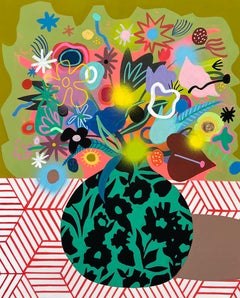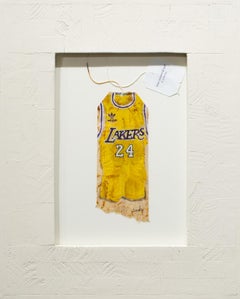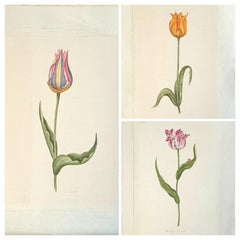Spray Paint Still-life Paintings
to
1
1
Overall Width
to
Overall Height
to
1
1
1
1
1
1
1
1
2,648
4
4
4
4
4
8
6
5
3
1
1
Medium: Spray Paint
Artist: Mary Finlayson
Spring Equinox 1_Mary Finlayson, Still Life_Flashe/Gouache/SprayPaint/Oil Sticks
Located in Laguna Beach, CA
Mary Finlayson
"Spring Equinox 1"
Flashe, Gouache, Spray Paint, Oil Stick on Canvas
25.25 x 21.25 inches, framed
Mary Finlayson’s interest in painting ...
Category
2010s Contemporary Spray Paint Still-life Paintings
Materials
Gouache, Canvas, Spray Paint
Related Items
R.I.P. Kobe
By Ruby Silvious
Located in Philadelphia, PA
This purple, white, beige and orange painting titled "R.I.P. Kobe" is an original artwork by Ruby Silvious made of watercolor and gouache on used tea bag. This...
Category
21st Century and Contemporary Contemporary Spray Paint Still-life Paintings
Materials
Found Objects, Watercolor, Gouache, Tea
Botanical Studies, Watercolours on Silk on Handmade Paper, Set of Three Tulips.
Located in Cotignac, FR
A set of three fine hand painted botanical watercolour studies on silk of tulips by La Roche Laffitte. The works are signed bottom right. Some are titled and numbered (see photos) Th...
Category
Late 20th Century Spray Paint Still-life Paintings
Materials
Watercolor, Gouache, Handmade Paper, Silk
$1,349 Sale Price
20% Off
H 21.19 in W 15.16 in D 0.04 in
Original Parisian Vintage Jewelry Design Art by Van Cleef & Boucheron Designer
Located in Cirencester, Gloucestershire
Braided Splendor: The Art of Twisted Gold Jewelry Design
circa mid 20th century
by Paul Touzet (French b. 1917)
original gouache painting, with penc...
Category
Mid-20th Century French School Spray Paint Still-life Paintings
Materials
Watercolor, Gouache, Pencil
Botanical Studies, Pair of Watercolours on Silk on Handmade Paper, Anemones
Located in Cotignac, FR
A pair of fine hand painted botanical watercolour studies on silk of anemones by La Roche Laffitte. The works are signed bottom right. Both are titled. The silk has been mounted on h...
Category
Late 20th Century Spray Paint Still-life Paintings
Materials
Silk, Watercolor, Handmade Paper, Gouache
$974
H 21.26 in W 15.56 in D 0.04 in
Original Parisian Vintage Jewelry Design Art by Van Cleef & Boucheron Designer
Located in Cirencester, Gloucestershire
Starlight and Feather Pendants Symbols of Grace and Strength Jewelry Design
circa mid 20th century
by Paul Touzet (French b. 1917)
original gouache painting, with pencil on tracing p...
Category
Mid-20th Century French School Spray Paint Still-life Paintings
Materials
Watercolor, Gouache, Pencil
Rambling Rose, Jo Haran, Contemporary Floral Artwork, Original Work On Paper
By Jo Haran
Located in Deddington, GB
Rambling Rose by Jo Haran [2020]
original
Gouache, watercolour ink and gesso.
Image size: H:72.5 cm x W:52.5 cm
Complete Size of Unframed Work: H:76 cm ...
Category
21st Century and Contemporary Contemporary Spray Paint Still-life Paintings
Materials
Gesso, Paper, Watercolor, Gouache
$480
H 29.93 in W 22.05 in
Jo Haran, Jewel Heads in Darkness, Contemporary Floral Art, Mixed Media Art
By Jo Haran
Located in Deddington, GB
Jewel Heads in Darkness [2021]
Original
Flowers
Gouache, watercolour ink and gesso.
Image size: H:53 cm x W:64 cm
Paper Size: H:56 cm x W:67.5 cm x D:0.01cm
Sold Unframed
Please note that insitu images are purely an indication of how a piece may look
'Jewel Heads in Darkness' is an original painting by Jo Haran. "I wanted to try and capture the frailty of anemones nestled in darkness. I used jewel colours....strong pink, yellow, hints of ultramarine and neon green as a contrast to the moody foliage backdrop."
'There are always flowers for those who want to see them" - Henri Matisse. "I have been painting flowers for over 20 years as an artist and as a senior textile designer selling prints to clients internationally including Valentino, Leonard, Paul and Joe and high street brands such as Topshop and Marks and Spencer...
Category
21st Century and Contemporary Contemporary Spray Paint Still-life Paintings
Materials
Gesso, Paper, Mixed Media, Watercolor, Gouache
$617
H 22.05 in W 26.58 in
Original Parisian Vintage Jewelry Design Art by Van Cleef & Boucheron Designer
Located in Cirencester, Gloucestershire
Timeless Love: Twisted Gold Heart Pendant Duo Jewelry Design
circa mid 20th century
by Paul Touzet (French b. 1917)
original gouache painting, with pencil on tracing paper
unframed
l...
Category
Mid-20th Century French School Spray Paint Still-life Paintings
Materials
Watercolor, Gouache, Pencil
Original Parisian Vintage Jewelry Design Art by Van Cleef & Boucheron Designer
Located in Cirencester, Gloucestershire
Leaf-Inspired Gemstone Accent Ring Jewelry Design
circa mid 20th century
by Paul Touzet (French b. 1917)
original gouache painting, with pencil on tracing paper
unframed
overall pape...
Category
Mid-20th Century French School Spray Paint Still-life Paintings
Materials
Watercolor, Gouache, Pencil
Original Parisian Vintage Jewelry Design Art by Van Cleef & Boucheron Designer
Located in Cirencester, Gloucestershire
Gold Necklace With Diamanté Arrows Jewelry Design
circa mid 20th century
by Paul Touzet (French b. 1917)
original gouache painting, with pencil on tracin...
Category
Mid-20th Century French School Spray Paint Still-life Paintings
Materials
Watercolor, Gouache, Pencil
Original Parisian Vintage Jewelry Design Art by Van Cleef & Boucheron Designer
Located in Cirencester, Gloucestershire
Golden Harvest: Leaf and Wheat Motif Cuff Bracelet Jewelry Design
circa mid 20th century
by Paul Touzet (French b. 1917)
original gouache painting, with pencil on tracing paper
stuck...
Category
Mid-20th Century French School Spray Paint Still-life Paintings
Materials
Watercolor, Gouache, Pencil
Original Parisian Vintage Jewelry Design Art by Van Cleef & Boucheron Designer
Located in Cirencester, Gloucestershire
intage Elegance Bows of Timeless Charm Jewelry Design
circa mid 20th century
by Paul Touzet (French b. 1917)
original gouache painting, with pencil on tracing paper
unframed
left des...
Category
Mid-20th Century French School Spray Paint Still-life Paintings
Materials
Watercolor, Gouache, Pencil
Spray Paint still-life paintings for sale on 1stDibs.
Find a wide variety of authentic Spray Paint still-life paintings available on 1stDibs. While artists have worked in this medium across a range of time periods, art made with this material during the 21st Century is especially popular. If you’re looking to add still-life paintings created with this material to introduce a provocative pop of color and texture to an otherwise neutral space in your home, the works available on 1stDibs include elements of blue, orange and other colors. There are many well-known artists whose body of work includes ceramic sculptures. Popular artists on 1stDibs associated with pieces like this include The Dotmaster, Jeremy Novy, Michael Callas, and Mary Finlayson. Frequently made by artists working in the Contemporary, Impressionist, all of these pieces for sale are unique and many will draw the attention of guests in your home. Not every interior allows for large Spray Paint still-life paintings, so small editions measuring 0.1 inches across are also available Prices for still-life paintings made by famous or emerging artists can differ depending on medium, time period and other attributes. On 1stDibs, the price for these items starts at $1 and tops out at $1,985,000, while the average work can sell for $2,197.
Recently Viewed
View AllMore Ways To Browse
Van Gogh Cafe Terrace
Tallulah Bankhead Portrait
Ted Fontaine
Texas Windmill Paintings
Thanh Le
The Highwaymen Paintings
Tom Howard Watercolor
Toy Sailboat
Travis And Co
Used Dior Jordan 1
Used Water Rower
Vasil Papkov
Vignobles De France
Vilhelms Purvitis
Vintage Banner Watch
Vintage Burlesque Dress
Vintage Cancan Dancer
Vintage Embalming


